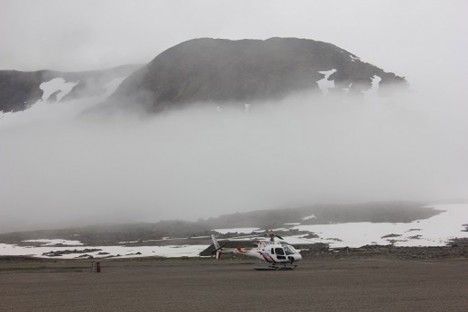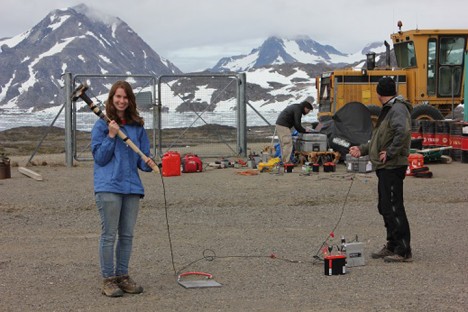Quizlet Depending on the Materials They Travel Through Seismic Waves Travel at Different What
Sending Seismic Waves Through the Ice
August 4th, 2015 by Lynn Montgomery and Nick Schmerr

Fog rolled in over the airport with the helicopter nosotros'll be using in the background.
Anatoly, Nick, and I arrived in Kulusuk on July 24 afterwards a very long journey from Maryland and France. We spent the mean solar day organizing and weighing gear from the container and are in serious need of a warm meal and good dark's sleep. This field flavour the seismic measurements are the top priority since they were delayed from the spring season.
The seismic portion of experiments will aid united states in agreement the subsurface hydrological structure and composition of the ice sheet. These experiments are crucial for agreement how deeply the aquifer layer extends into the firn and capturing the variation in its thickness across the water ice sail. The primary focus of our experiment is to use seismometers to measure out the velocities of layers within the ice sheet. Based upon the various phases of h2o (water ice, snow, and liquid h2o) nowadays, nosotros await to run into different wave speeds for each material. Past examining how these wave speeds modify with depth, we can deduce the relative amounts of how much h2o, ice, or snow is at depth.
To obtain these measurements, we will be using an active source seismic array that is being provided to united states past the Incorporated Research Institutions for Seismology Portable Array Seismic Studies of the Continental Lithosphere Instrument Center. The array consists of multiple geophones attached to a towable streamer cable that will capture seismic waves propagating both forth the surface and down through the water ice sheet. Nosotros can motion the array past towing it behind a snowmobile. To generate the seismic waves, nosotros strike an aluminum plate with a sledgehammer to propagate a moving ridge into the ice sheet. A unmarried hammer strikes is typically called a "shot." A multichannel seismic data collector connected to the seismometers then collects the ground motion recorded at each geophone, and sends the data to a calculator where we can expect at how long it took for the seismometers to receive data at different distances from the shot origin.
Equally the seismic waves travel through the ice, the time it takes for the seismometer to receive the vibration from the shot will be shorter or longer depending on the different velocities of material the wave travelled through. Past looking at a number of different locations, we can and then map out geographical variations in the thickness and graphic symbol of the subsurface ice sheet structure. This endeavour is vital for understanding how h2o is flowing through the layers of our ice sheets in order to run into how the melt is affecting sea level rise globally.
We programme on leaving for the water ice canvass very soon and hope we got all of our bad luck with delays out of the way last season.

Nick and Olivia having tiffin in Kulusuk.

Lynn, Nick, and Anatoly testing out the seismic gear at the airport.
Tags: cryosphere, drilling, Greenland, Greenland Aquifer Trek 2015, ice
0 Response to "Quizlet Depending on the Materials They Travel Through Seismic Waves Travel at Different What"
Post a Comment